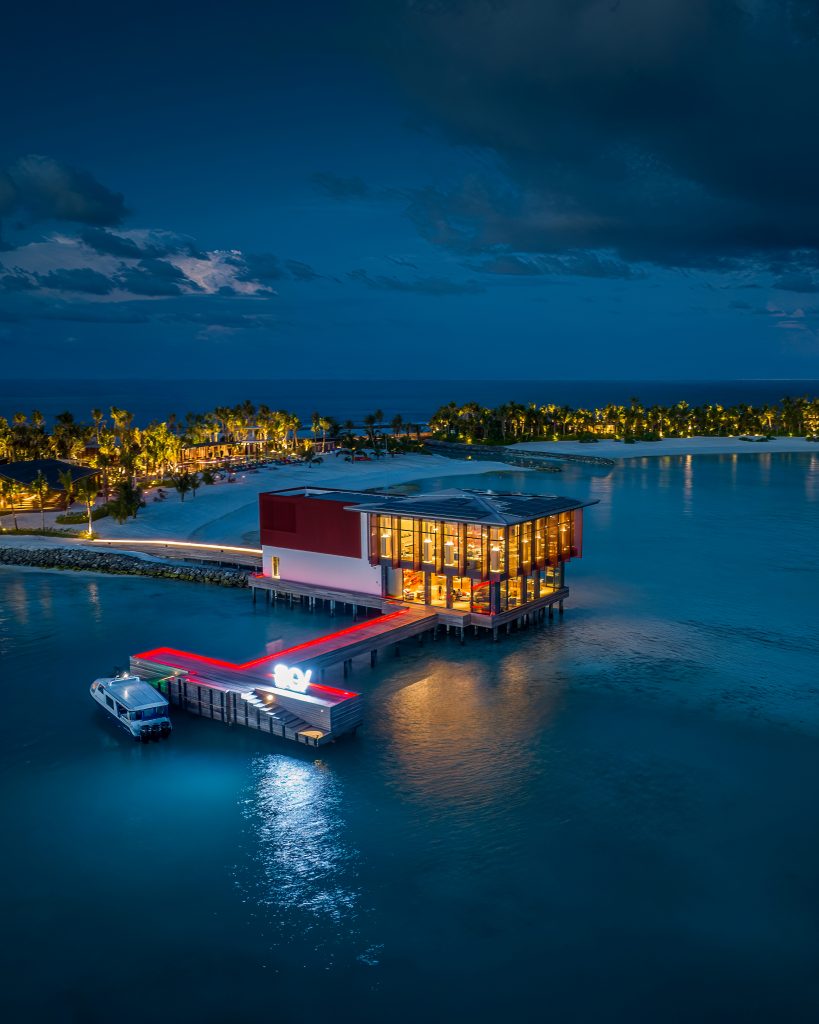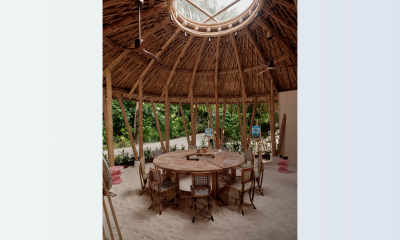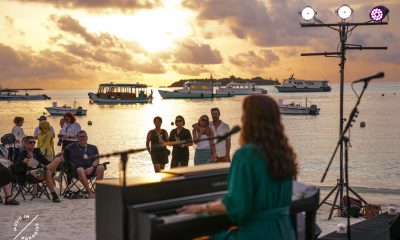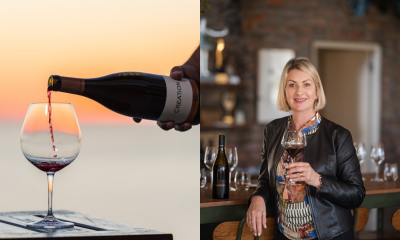Culture
Holiday Inn Resort Kandooma Maldives celebrates Maldivian heritage

Holiday Inn Resort Kandooma Maldives showcases the archipelago nation’s rich Maldivian heritage to holidaymakers through specially curated guest experiences centred on exploration and learning.
Guests are invited to experience the “Spirit of the Maldives” Tuesday weekly event, which features a lavish buffet dinner with all the traditional favourites. Local Maldivian cuisine is influenced by the familiar flavours and spices used in Indian and Arabic cuisine. It has a particular emphasis on readily available foods such as fresh Tuna fish, chilli and coconut. The evening also includes a lively cultural performance of dance, song, music and light by the Kandooma Bodu Beru dance troupe, where rhythmic drumming, graceful movement and soulful singing tell stories of the islands’ history and folklore captivating the audience with their artistry. US $69++ for Adults and complimentary for Children (U12).
For those eager to delve deeper into the culinary traditions, “Maldivian Masterclasses” are held twice each week (3 pm to 4 pm on Tuesdays and Saturdays) and offer a group cooking class experience where participants can learn the secrets to the flavours and food combinations from the resort’s talented chefs. The experience is completed with a tasting session and recipes to recreate the dishes when they return home to share with family and friends. The classes are limited to 8 people. US $80 per person, adults only.
Discover your rhythm and beat in a complimentary “Bodu Beru Drumming Class” held each Saturday morning at the Resort. Learn about the relevance of Bodu Beru and the
large drums (traditionally made from coconut wood and covered with goat or manta ray skin) that provide a robust and captivating beat that often starts with a slow, steady rhythm that builds intensity and is accompanied by chanted lyrics. Complimentary for everyone.
“Our cultural showcase is a terrific opportunity for visitors to learn about the Maldives while staying with us. Whether they learn to play Bodu Beru, savour local delicacies, or enjoy a captivating performance, the experiences provide an unforgettable journey into the heart of island culture and make memories to last a lifetime,” said Mark Eletr, General Manager, Holiday Inn Resort Kandooma Maldives.
“It makes a big difference to the guest experience to have an international staff where foreign visitors can minimise language barriers, and we’re proud to do that for our key markets. But what guests remark on the most is how lovely it is to see Maldivian people working at Kandooma and sharing their stories and bright smiles. Our Maldivian team members have a special warmth about them, and when guests feel it too, it gives me that warm, fuzzy feeling. It’s very special.” he added.
Holiday Inn Resort Kandooma Maldives proudly aims to have a team comprised of more than 40% local Maldivian people. A key element of the resort’s Sustainability commitment is to support local communities and economies and promote the culture. In doing so, Mark Eletr says the team intends for guests to leave with special memories of their time in the Maldives and a deep sense of connection through the showcased activities and the experiences that will stay with them long beyond their visit.
Kandooma Maldives creates an atmosphere of warmth and hospitality while reflecting the genuine spirit of the Maldivian people.
Located in the South Male atoll just 40 minutes from the airport by boat, Holiday Inn Resort Kandooma Maldives is a beautiful, natural island paradise. White sand beaches, swaying coconut palms and turquoise waters form the backdrop for leisure pursuits and some of the best scuba diving in the Maldives. Guests can choose from Garden and Beach Villas, two-storey Beach Houses and the popular Overwater Villas. Families are well catered for with a choice of 2- and 3-bed villas and the Kandoo Kids’ Club with its fun activities programme. Six food and beverage outlets ensure healthy appetites are satisfied and the flavours of the Maldives are explored. Guests seeking time out and relaxation will enjoy sun-loungers and hammocks dotted around the island. Kandooma Spa by COMO Shambhala offers a tranquil escape for body and mind.
Culture
SO/ Maldives illuminates Diwali with culinary delights, festive spirits, chic island vibes

This Diwali, SO/ Maldives is set to dazzle with a bold celebration that blends cultural tradition with the resort’s signature flair. Guests are invited to indulge in a day of flavor, music, and style, wrapped in the spirit of light and festivity.
The day begins at The Citronelle Club, where guests can immerse themselves in India’s sweetest traditions with a complimentary Gulab Jamun cooking class. This hands-on session not only celebrates the art of crafting one of India’s most iconic desserts but also offers guests a memorable experience of cooking and tasting together in true festive spirit.
Following the workshop, the culinary journey continues with an exclusive tasting of SO/ Maldives’ brand-new Indian à la carte menu. Bursting with bold flavors and modern interpretations, this exciting menu brings a fresh twist to traditional favorites, showcasing dishes designed to delight both seasoned gourmands and those discovering Indian cuisine for the first time.
As the afternoon rolls into evening, the celebrations flow seamlessly to Lazuli Beach Club and The Citronelle Club, where guests can savor the moment with 40% off select premium beverage bottles. Whether shared over a meal or enjoyed as a toast to togetherness, these indulgent pours elevate the festive mood with sophistication.
The evening comes alive with a vibrant lineup of cultural and family-friendly activities. Guests can express their creativity at a Family Diya Workshop, lighting up the night with personalized clay lamps that symbolize joy and prosperity. At Lazuli Beach Club, a Henna Workshop invites guests to adorn their hands with intricate patterns, while the beachfront transforms into a canvas for a Rangoli experience, where colorful designs bloom in the sand to celebrate the artistry and spirit of Diwali.

No Diwali celebration is complete without a golden-hour glow. At Lazuli Beach, the festivities shine brighter with 50% off saffron martinis during sunset, accompanied by live DJ beats. As the Maldivian sky turns to hues of orange and gold, guests can sip, sway, and soak in an electric yet elegant atmosphere, perfectly in tune with the spirit of Diwali.
“At SO/ Maldives, we reimagine cultural celebrations with a bold, chic island twist. This Diwali, we’ve curated a day that’s all about indulgence, flavors, music, and unforgettable moments,” said Olivier MOIES-DELVAL, General Manager, SO/ Maldives. “It’s about honoring tradition while celebrating in style, surrounded by the natural beauty and energy of the Maldives.”
SO/ Maldives invites guests to light up their Diwali with this one-of-a-kind experience that blends the richness of Indian traditions with the resort’s signature playful luxury.
Celebrate light, flavor, and island chic this Diwali at SO/ Maldives.
Cooking
Malaa – The Maldivian Café: NH Kuda Rah’s new culinary jewel

NH Maldives Kuda Rah has announced the launch of its newest food and beverage outlet, Malaa – The Maldivian Café. Now open to guests, the café offers a taste of authentic Maldivian cuisine alongside interactive Maldivian cooking classes.
Guests staying at NH Maldives Kuda Rah can delve into the country’s rich culinary traditions with guidance from award-winning Executive Chef Farish Mukhthar. With over 22 years of experience in the hospitality and culinary industries across five-star and ultra-luxury resorts in the Maldives, Chef Farish brings a deep-rooted passion and refined expertise to the resort. Trained under renowned European celebrity chefs, he has earned a strong reputation for his culinary artistry.
The café focuses exclusively on authentic Maldivian dishes, using locally sourced ingredients from nearby islands as well as the chef’s own garden within the resort. Cooking classes offer guests the opportunity to prepare classic Maldivian dishes, such as curry and local salads, under the guidance of Chef Farish—culminating in a delicious homemade lunch.
As fish (both fresh and smoked) is the staple of the Maldivian diet, it is often prepared with coconut and rice or roshi (Maldivian flatbread). Other traditional ingredients include breadfruit and sweet potato—versatile and starchy staples that feature in a wide range of local dishes. The cuisine is often boldly spiced, with the fiery Scotch bonnet chilli, locally known as githeyo mirus, playing a central role. This essential chilli, along with herbs grown organically in the resort’s garden, imparts a distinctive heat and fruity flavour to many Maldivian dishes.
While many resorts in the Maldives offer a wide array of international cuisine—ranging from Italian and Japanese to French and Indian—the opportunity to savour authentic local flavours can be one of the most memorable aspects of travel. Malaa – The Maldivian Café provides a unique and immersive dining experience for those curious about Maldivian culinary heritage and the fascinating stories behind its traditional ingredients.
This initiative is part of NH Hotels & Resorts’ broader effort to connect guests with meaningful local experiences through its Live Local programme, under the Minor DISCOVERY loyalty scheme. The programme is designed to offer curated, immersive activities and authentic cultural encounters, allowing guests to engage more deeply with their destination.
Culture
Milaidhoo Maldives invites guests to discover real island living in Kihadhoo

Milaidhoo Maldives, a boutique luxury resort situated within the UNESCO Biosphere Reserve of Baa Atoll, has unveiled its latest signature offering – the Local Island Tour – a meaningful and intimate cultural experience that provides guests with a genuine insight into everyday life in the Maldives.
Nestled amidst the natural splendour of Baa Atoll, celebrated for its vibrant marine biodiversity and unspoilt local islands, this new experience extends beyond the boundaries of the resort. Guests are invited to journey just 15 minutes by boat to Kihadhoo, a serene and authentic island where tradition, community and simplicity remain firmly embedded in daily life.
Upon arrival, visitors are immersed not only in a new landscape but in a slower, more deliberate way of life. Much like the ethos of Milaidhoo, where barefoot luxury is designed to encourage presence and connection, Kihadhoo exudes its own quiet charm – a lifestyle shaped by nature, calm and community. Along its sandy paths, occasionally crossed by a scooter or two, time appears to slow down. It is a place grounded in authenticity and understated beauty.
The experience is personally guided by Ali “CR” Niushad, a Kihadhoo native and esteemed member of the Milaidhoo team. Acting as both host and storyteller, CR offers guests the rare opportunity to experience the island not as tourists, but as warmly welcomed friends. The visit begins with a traditional greeting from local flower girls dressed in Maldivian attire, setting the tone for an encounter steeped in culture and sincerity.
As the tour unfolds, guests are met with the everyday sights and sounds of the island: children waving in the distance, neighbours exchanging greetings, the rhythmic sweep of a broom, the gentle clatter of cooking utensils, and women gathered in joali seats, softly conversing in the afternoon light. A walk through Kihadhoo reveals vividly painted doors on homes – reminiscent of the colourful doors of Milaidhoo’s own villas – reflecting the island’s quiet charm and creative spirit.
This is not a traditional sightseeing excursion; it is an immersion into the heartbeat of island life. Guests enjoy fresh coconuts at a small, family-run café, visit the local school and community centres, and spend time in CR’s family home, sharing stories and perspectives. Each moment is organic, heartfelt, and grounded in sincere human connection.
In an era where travellers increasingly seek meaningful and mindful experiences, Milaidhoo’s Local Island Tour captures the spirit of slow travel: an invitation to pause, observe, and engage with respect and curiosity.
Experience Highlights:
- Price: USD 95++ per person (minimum of four guests)
- Inclusions: Return boat transfers, traditional island welcome, guided walk with CR, refreshments (fresh juice or coconut), visits to village landmarks, and a selection of homemade Maldivian snacks with tea or coffee
While Milaidhoo offers refined barefoot luxury that nurtures a sense of inner calm, Kihadhoo presents the soulful essence of Maldivian island life. Together, they create a compelling contrast – sanctuary and simplicity, elegance and authenticity.
This experience is more than a cultural outing. It is a return to the original purpose of travel: to connect, to learn, and to be changed in quiet, unforgettable ways.
-

 News1 week ago
News1 week ago‘Around the World in Wonder’ brings culture, cuisine, celebration to Amilla Maldives
-

 News1 week ago
News1 week agoFour Centara resorts in Maldives target school-holiday travellers with extended-stay offers
-

 News6 days ago
News6 days agoCinnamon Hotels & Resorts Maldives wraps Christmas celebrations, prepares NY 2026 line-up
-

 News7 days ago
News7 days agoKuda Villingili Resort Maldives marks Year of the Horse with four-day Lunar New Year programme
-

 News6 days ago
News6 days agoHoliday Inn Resort Kandooma Maldives unveils week-long Orthodox Christmas celebrations
-

 News5 days ago
News5 days agoSun Siyam Vilu Reef brings ‘Ocean Odyssey’ to life this festive season
-

 News4 days ago
News4 days agoSun Siyam Olhuveli marks end of 2025 with sustainability-led programmes
-

 News4 days ago
News4 days agoFinolhu unveils ‘A Year in Colour’ with global artist residencies in 2026













